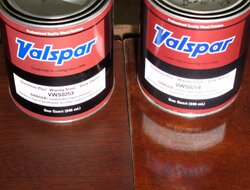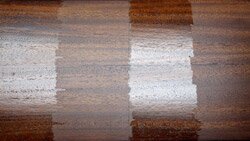-
The Role of Flatting Agent in Creating Sheen
The sheen of a finish is the degree of light reflection when a surface is viewed at a low angle. In a high sheen or high gloss surface, you see glare or a distinct reflected image. In a low sheen, satin or flat surface, glare and reflection are softened to the point of non-existence.

Flatted finishes (left) produce little or no reflection while gloss finishes with no flatting agent added (right) reflect glare and image
Oil finishes always produce a softened satin sheen. Wax finishes produce a little more shine than oil. All film-building finishes—varnish, lacquer, water-based finish and shellac—can be made to have any sheen, from high gloss to very flat.
There are two ways to produce a flatted sheen: rub the finish with abrasives of various grits to produce the sheen you want, or use a finish with the sheen already built in by the inclusion of a “flatting agent.” Varnish (including polyurethane varnish), lacquer and water-based finish are available in several sheens. Shellac is supplied only in gloss.
Both methods of creating a flatted sheen—rubbing with abrasives and using a product containing flatting agent—work by creating a microscopically rough surface that reflects light randomly.
This article is about the role of flatting agent and how it works.
Flatting agent
Flatting agent is the solid stuff that settles to the bottom of a can of clear finish and has to be stirred into suspension before use. If a finish doesn’t contain a flatting agent, the finish will be glossy when it dries.
The flatting agent is composed of small particles of solid material, usually amorphous silica, the nature of which makes the particles invisible and transparent in the cured finish film. As the wet finish shrinks during drying, it pulls taut over the particles near the surface, and this creates the micro-roughness that gives the flatted effect.
The particles aren’t exposed; they are shrink wrapped by the finish film. You see the shrink wrapping occurring as you watch the flatted finish dry. At first, when you apply the finish, the film is glossy. But as the solvent or thinner reaches a certain point of evaporation, the flatting appears rather suddenly.
In most cases you buy the finish with the flatting agent already added. But flatting agent, usually called “flatting paste,” is available separately from suppliers to the professional finishing trade for you to add yourself.
Most manufacturers of flatted finishes use loosely defined terms, such as semi-gloss, satin, eggshell, flat and matte, to describe what they are selling you. Some manufacturers who sell to professional finishers use a numbering system that runs from 90 (high gloss) down to 10 (very flat). This is the more accurate and helpful system and should be used by everyone.
Few manufacturers targeting non-professionals offer more than two or three choices of sheen. Most sell only gloss and satin. Even with just these two varieties, however, you still have total control over the sheen you will get simply by pouring off some of the gloss from a can of satin in which the flatting agent has settled and mixing the two parts.
Add more of the poured-off gloss to get an in-between sheen. Add more of the remaining flatted part to get a flatter sheen than you began with.
Be sure to keep the store clerk from shaking the can, or let the can sit undisturbed on your shelf for several weeks before pouring off some of the gloss.
Because the flatted effect is created by a roughened surface, it should be obvious that a flatted sheen can be made glossy in the same way that a rubbed satin or flat sheen can. Simply level the surface with fine sandpaper, then polish with very fine abrasives.
Likewise, a gloss sheen can be made satin or flat by rubbing with abrasives that produce the sheen you want.
In other words, you have total control over the sheen you end up with.
Myths
There are two common myths about flatting agent that are often repeated among professional finishers and store clerks.
The first is that the flatting effect is cumulative either because each coat adds to the flatness of the previous coat, or, in the case of lacquer, because all the flatting agent from each coat floats to the top of the last coat applied.
The second is that flatting agent weakens the scratch resistance of the finish film.
Cumulative Effect
Because the flatted effect is created not by the particles embedded deep within each coat of finish film, but only by those particles located near the surface, there is no cumulative effect caused by applying more coats. The only way to increase the flatness of a finish is to add more flatting agent to it. You can continue to apply coat after coat of any given flatness and the resulting sheen will not change. It’s the last coat applied that establishes the sheen.

It’s the last coat of finish applied that determines the sheen. This is true with all finishes. The left quarter of this panel has three coats of gloss polyurethane varnish applied. The second quarter has three coats of gloss followed by one coat of satin. The third quarter has three coats of satin polyurethane varnish followed by one coat of gloss. The right quarter has three coats of satin. There’s no difference in the gloss of the first and third quarters even though the third quarter has three coats of satin underneath. And there’s no difference in the satin of the second and fourth quarters even though the second has three coats of gloss underneath.
You can easily confirm this by applying a gloss coat over a satin or flat coat. When the finish has dried, the surface will be glossy just as if all the coats had been gloss.
Nor does flatting agent rise to the top of a coat of finish. If anything the flatting agent settles, just as it does in a can. At any rate, flatting agent surely doesn’t transfer from one coat to another.
This myth may have gotten started because finishers have noticed that a flatted finish can become glossy after years of use. What has really happened, of course, is that the micro-roughness on the surface has been leveled and polished by wear, and the remaining flatting agent in the film is transparent.
Scratch resistance
Many flatted finishes appear to scratch more easily than gloss finishes (though a flatted finish doesn’t show scratches as clearly as a gloss finish). But because the particles at the surface are all covered (shrink wrapped) with the finish, there can’t be any difference in scratch resistance.
There can, however, be the appearance of less scratch resistance because it’s easier for coarse objects to level the micro-bumps than to dig into a level film.
To aid in resisting micro-bump leveling, many manufacturers use wax-coated, amorphous silica, but there’s no way for you to know in advance because this information is never provided.
The wax-coated particles serve an additional purpose of keeping the flatting agent from clumping at the bottom of the can and also from clumping around the lip of the can after you have poured some finish from it. Clumping, if it does occur, shows up as tiny white specks in the finish and is impossible to redissolve. You’ll have to switch to a fresh can of finish, in which case I would suggest changing brands.
Essentials for Every Woodworker, Novice or Master Woodworker

Blow Off Tool In Action

ECO5 ECO-LOGICAL, ECO-NOMICAL TURBINE SYSTEM Efficient 5 stage turbine

Painters Pyramid Effortless and "touch free"

Nour AquaGlide Plus Nylon Fine Bristle Brush

Erecta-Rack quickly and effectively dry doors and shelves
